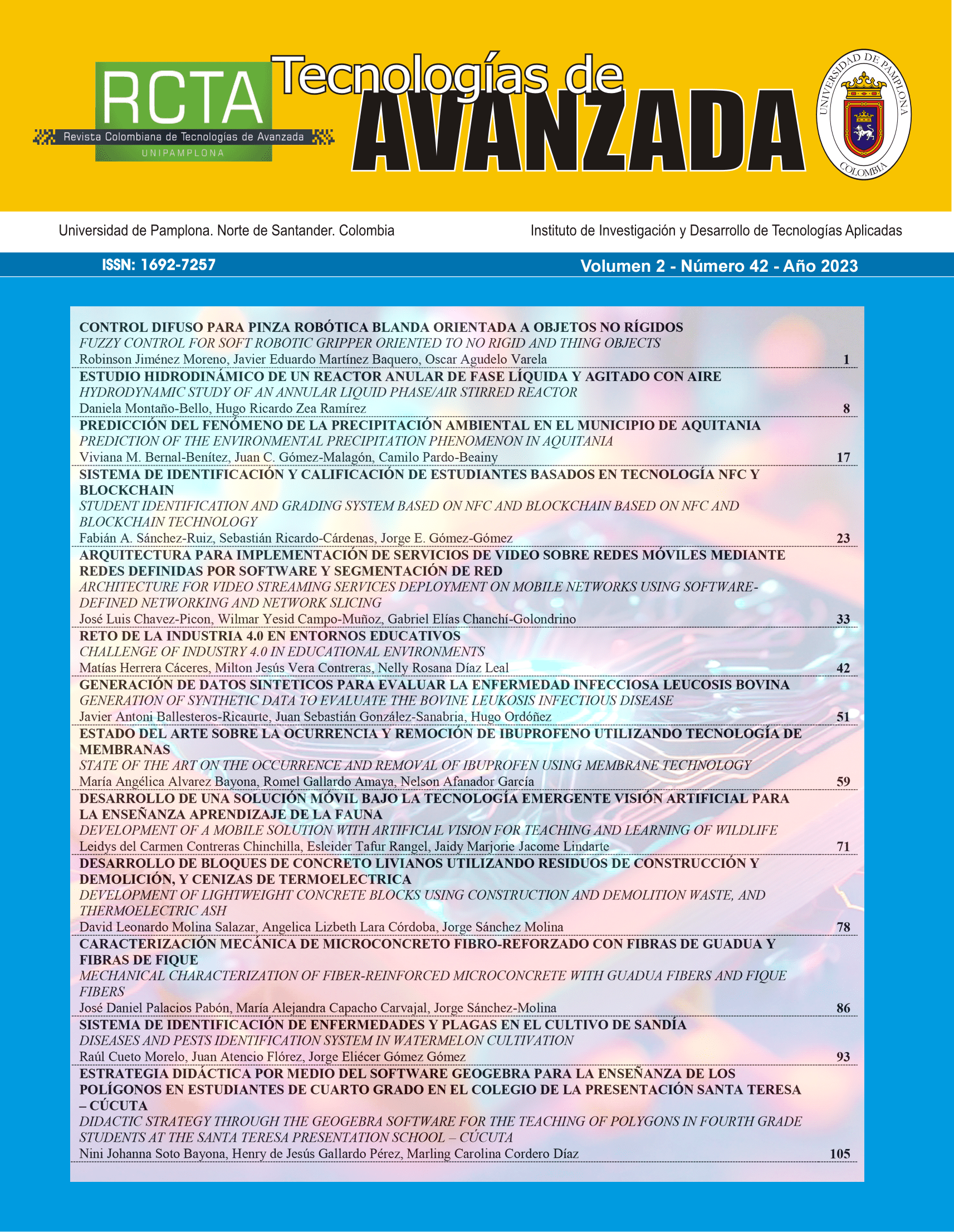Estrategia didáctica por medio del software GeoGebra para la enseñanza de los polígonos en estudiantes de cuarto grado en el Colegio de la Presentación Santa Teresa – Cúcuta
DOI:
https://doi.org/10.24054/rcta.v2i42.2687Palabras clave:
Enseñanza, Aprendizaje, Polígonos, Geometría, Software, Pensamiento GeométricoResumen
La Educación está en constante búsqueda de la calidad educativa, por este motivo se han indagado diferentes maneras para cambiar la educación tradicional, al hacer uso de nuevas estrategias didácticas en las que se incluye la utilización de herramientas tecnológicas. Ahora bien, para la enseñanza del área de matemáticas en la actualidad se trata de salir de lo convencional; por esto, los docentes han visto la necesidad de emplear software educativo, entre los cuales se encuentra el Software Geogebra para la enseñanza de diversas temáticas, las cuales deben ser abordadas de acuerdo al grado en el que los estudiantes se encuentran. El desarrollo de este proyecto tiene como propósito principal crear una estrategia didáctica por medio del software Geogebra para la enseñanza de los polígonos en estudiantes de cuarto grado. Para llevarlo a cabo se requirió hacer uso de un enfoque de investigación mixto porque de esta forma fue posible recolectar toda la información necesaria para darle cumplimiento a los objetivos planteados y así dar una solución a la problemática abordada en el estudio. De igual forma, se tuvo en cuenta una triangulación recurrente que permitió vincular métodos cualitativos y cuantitativos para cumplimiento de los objetivos establecidos. La investigación se realizó con la participación de 31 estudiantes a quienes se les aplicó un test con preguntas abiertas para realizar la prueba diagnóstica, el cual permitió identificar las fortalezas y falencias que tenían los estudiantes con respecto a la temática de los Polígonos. Además, se realizó observación participante para de esta manera poder llevar a cabo las diferentes actividades para la enseñanza de los polígonos y una entrevista semiestructurada. Los resultados arrojaron que existe en primera instancia apatía por la asignatura que se refleja en los resultados académicos de los estudiantes. Al hacer un análisis de los resultados del pre-test se puede decir que existen deficiencias en cuanto a la temática porque una gran mayoría de los estudiantes no obtuvieron resultados favorables y presentan deficiencias en la identificación de las propiedades de los polígonos, pero estas falencias encontradas se lograron mejorar después de realizar actividades didácticas haciendo uso del software Geogebra, ya que así se evidenció en los resultados del postest superan de manera significativa a los del pre-test y los estudiantes desarrollaron habilidades para la identificación de polígonos y sus propiedades manifestando que las actividades desarrolladas con el software fueron divertidas y de aplicabilidad al contexto en el que se encuentran.
Descargas
Referencias
Alvarado, L. y Gracía, M. (2008). “Características más relevantes del paradigma socio-crítico. Sapiens”. Revista de investigación, Vol. 9, No. 2, pp. 187-202
Álvarez-Gayou L. (2006). Cómo hacer investigación cualitativa. Paidós, México.
Arteaga, E., Medina, J. y Martínez, J. (2019). “El Geogebra: una herramienta tecnológica para aprender Matemática en la Secundaria Básica haciendo matemática”. Revista Conrado. Vol. 15, No. 70, pp. 102-108.
Benlliure, V. (2019). Teoría y práctica de la creatividad, Valencia: Universidad de Valencia.
Camargo, C y Acosta, M. (2012). La geometría, su enseñanza y su aprendizaje, Valencia: Universidad de Valencia.
Canizales, J. (2004). “Estrategias didácticas para activar el desarrollo de los procesos de pensamiento en el preescolar”. Investigación y Postgrado. Vol. 19, No. 2, 179-200.
Cardeño, J. y Córdoba, F. (2013). Innovación en la enseñanza de las matemáticas. Bogotá: Fondo Editorial ITM
Elliott, J. (200). La investigación-acción en educación. Buenos Aires: Ediciones Morata
Gallardo H, Vergel M, Villamizar F. (2017). “Investigación intervención y enfoque multimétodo en ciencias humanas y educación matemática”. Logos, Ciencia y Tecnología. Vol. 9, No. 2, pp. 85-96
Habermas, J. (1988). La lógica de las ciencias sociales. Madrid: Editorial Tecnos
Hernández, R. y Mendoza, C. (2018). Metodología de la investigación: las rutas cuantitativa, cualitativa y mixta. México: McGraw Hill.
Herrera, J. y Ochoa, E. (2022). “Análisis de la relación entre educación y tecnología”. Cultura, Educación y Sociedad. Vol. 13, No. 2, pp. 47-68.
Lazo, M. (2009). “David Asubel y su aporte a la Educación”. Revista Ciencia UNEMI, Vol. 2, No. 3, pp. 20-23
López, O. y García, S. (2008). La Enseñanza de la Geometría. México: Instituto Nacional para la Evaluación de la Educación.
Morales, A y Damián, A. (2021). “Estrategia didáctica fundamentada en el uso de GeoGebra para mejorar la comprensión del concepto de semejanza de triángulos”. Innovación educativa, Vol. 21, No. 87, pp. 11-33
Núñez, J. (2017). “Los métodos mixtos en la investigación en educación: hacia un uso reflexivo”. Cuadernos de Pesquisa, Vol. 47, No. 164, pp. 632-649.
OECD. (2018). Results from PISA 2018. Colombia - Country Note - PISA 2018 Results.
Ospina, C. (2017). Las Tic como herramienta de motivación en el aula. Bogotá: Universidad de la Sabana
Pereira, Z. (2011). “Los diseños de método mixto en la investigación en educación: Una experiencia concreta”. Revista Electrónica Educare, Vol 15, No. 1, pp. 15-29
Sánchez, R. y Borja, A. (2022). “Geogebra en el proceso de Enseñanza-Aprendizaje de las Matemáticas”. Dominio de las Ciencias. Vol. 8, No. 2, pp. 33-52
Viera, T. (2003). “El aprendizaje verbal significativo de Ausubel. Algunas consideraciones desde el enfoque histórico cultural”. Universidades. No. 26, pp. 37-43.
Descargas
Publicado
Número
Sección
Licencia
Derechos de autor 2023 Nini Johanna Soto Bayona, Henry de Jesús Gallardo Pérez, Marling Carolina Cordero Díaz

Esta obra está bajo una licencia internacional Creative Commons Atribución-NoComercial 4.0.











